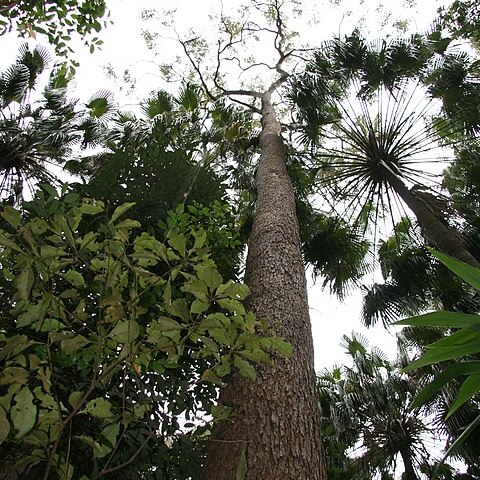Tree to 35 m tall. Forming a lignotuber.Bark rough and tessellated to the small branches, often thick and furrowed, grey or brown.Juvenile growth (coppice or field seedlings to 50 cm): stem rounded in cross-section, scabrid at first, becoming smooth; juvenile leaves always petiolate, peltate for ca 10 nodes, opposite for 3 to 7 nodes then sub-opposite to alternate, lanceolate, 8–16 cm long, 2–4.2 cm wide, base of lower leaves peltate, eventually tapering to petiole, discolorous, green, scabrid at first particularly on petiole and midrib, eventually smooth.Adult leaves alternate, petiole (0.8)1.2–2.5 cm long; blade lanceolate, 8–15 cm long, 1.3–4 cm wide, base tapering to petiole, discolorous, glossy or dull, green, strongly penniveined, densely to very densely reticulate, intramarginal vein parallel to and just within margin, oil glands island or absent.Inflorescence terminal compound, peduncles 1–2 cm long; buds 7 per umbel, pedicels 0.2–1.5 cm long. Mature buds pyriform to obovoid, 0.7–1 cm long, 0.4–0.6 cm wide, green to yellow or creamy, smooth, without ridges, scar absent (both opercula shed together at flowering), operculum conical to rounded to beaked, stamens inflexed, anthers cuboid or cuneate, versatile, dorsifixed, dehiscing by longitudinal slits (non-confluent), style long, stigma tapered or mop-like, locules 3 or 4, the placentae with ovules not arranged in distinct vertical rows. Flowers white.Fruit pedicellate (pedicels 0.2–1.5 cm long), ovoid to barrel-shaped, the neck short, 1–2 cm long, 0.8–1.6 cm wide, appearing speckled, disc descending, valves 3 or 4, enclosed.Seeds brown or reddish brown, (4)6.5–9(11) mm long, ellipsoidal with terminal wing, surface smooth, hilum close to one edge, ventral. Cultivated seedlings (measured at ca node 10): cotyledons reniform to orbicular; stems rounded in cross-section, scabrid; leaves always petiolate with peltate insertion of petiole on lamina for at least 9 or 10 nodes, opposite for 3 to 7 pairs, sometime 15 pairs, then alternating, elliptic to ovate, 5.5–13 cm long, 2–5.5 cm wide, discolorous, dull, darker green above. Leaves scabrid on underside and petiole.
More
Tree to 30 m with a long, straight trunk. Bark tessellated, light grey or light brown throughout. Juvenile leaves opposite, then alternate, petiolate, broadly lanceolate, sometimes peltate, setose but becoming glabrous. Adult leaves alternate, lanceolate or broadly lanceolate, acuminate; lamina 9–16 cm long, 1.5–3 cm wide, shining, dark green, discolorous; lateral veins faint, at 60°–70°; intramarginal vein confluent with margin; petiole channelled or terete, 8–20 mm long. Umbels 7-flowered; peduncle terete or slightly angular, 10–18 mm long; pedicels 2–14 mm long. Buds pyriform to obovoid; operculum conical, 2–4 mm long, 4–6 mm wide; hypanthium truncate-pyriform, 5–9 mm long, 4–7 mm wide. Fruits urceolate or ovoid, 11–21 mm long, 8–16 mm wide. Seeds winged, yellow-brown to red-brown.
A medium to tall tree. It grows 15-30 m high. It spreads 10-20 m wide. The bark is grey-brown and cracked into squares. The leaves are sword shaped and glossy. The juvenile leaves are 4-18 cm long by 2-6 cm wide. The adult leaves are 8-15 cm long by 2-3 cm wide. The flowers are cream and occur in masses.


